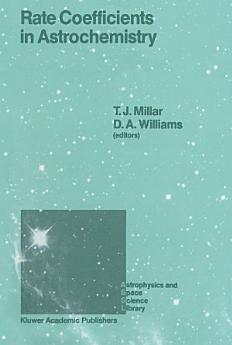Rate Coefficients in Astrochemistry: Proceedings of a Conference held at Umis, Manchester, U.K. September 21–24, 1987
T.J. Millar · D.A. Williams
dec. de 2012 · Astrophysics and Space Science Library Libro 146 · Springer Science & Business Media
Libro electrónico
364
Páxinas
reportAs valoracións e as recensións non están verificadas Máis información
Acerca deste libro electrónico
''An atteJDpt has been made to cOll1PlJte the numbers of certain JI10lecules in interstellar space , . . . . A search for the bands of CH, O/{, DR, en and C2 would appear to be proIDising" P Swings and L Rosenfeld Astrophysical Journal 86,483(1937) This may have been the first attempt at modelling interstellar chemistry. As with models today, the methods used lacked reliability, but the speculation was impressive! Mark Twain might well have said of this infant subject "One gets such wholesale returns of conjecture out of such a trifling investment of fact". The detection of unidentified lines around the period that Swings and Rosenfeld were writing provoked much interest, but even the most optimistic speculator could hardly have imagined developments which would occur during the next 50 years. By 1987 about 70 varieties of molecule had been identified in the interstellar and circumstellar regions, They range in complexity from simple diatomics such as H2 and CO to such species as ethanol C2HeDH, acetone (CHs)2CO, and the largest interstellar molecule detected so far, cyano-penta acetylene HC11N, The study of these molecules in astronomy has developed enormously, especially over the last 20 years, and is now codified in the new subject of astrochemistry, That such a variety of chemical species should exist in tenuous regions of the Galaxy is fascinating.
Valora este libro electrónico
Dános a túa opinión.
Información de lectura
Smartphones e tabletas
Instala a aplicación Google Play Libros para Android e iPad/iPhone. Sincronízase automaticamente coa túa conta e permíteche ler contido en liña ou sen conexión desde calquera lugar.
Portátiles e ordenadores de escritorio
Podes escoitar os audiolibros comprados en Google Play a través do navegador web do ordenador.
Lectores de libros electrónicos e outros dispositivos
Para ler contido en dispositivos de tinta electrónica, como os lectores de libros electrónicos Kobo, é necesario descargar un ficheiro e transferilo ao dispositivo. Sigue as instrucións detalladas do Centro de Axuda para transferir ficheiros a lectores electrónicos admitidos.









